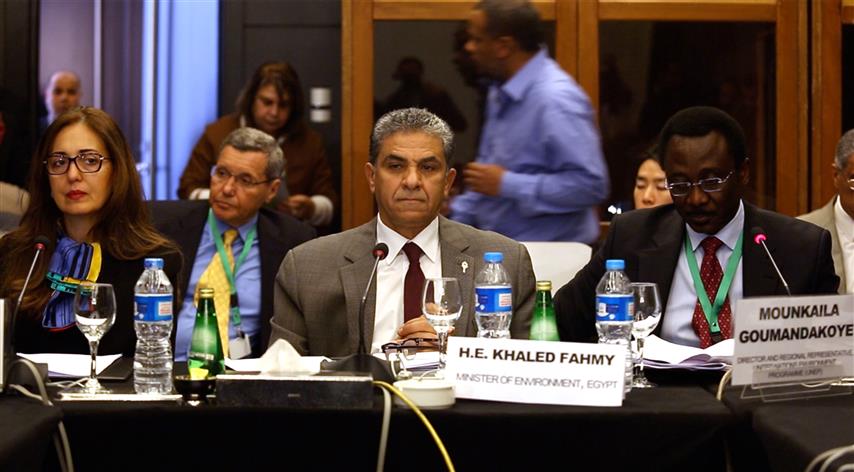Over thirty African Ministers of the Environment gathered in Cairo during the first week of March 2015, coinciding with the creation of AMCEN – the African Ministerial Conference on the Environment – thirty years ago in this very same place.
Needless to say, it was a very different world in those days: thirty years ago, few but a handful of committed scientists understood the nature and risks posed by high atmospheric concentrations of CO2. Thirty years ago, outside of disciplines related to earth sciences, few understood the threats posed by looming ecological scarcities, from fresh water to clean air to a dwindling stock of biological diversity and related streams of ecological services. And notably, precious few economists had made the link between these emergent scarcities, our underlying model of consumption-led growth, and the potential risks they represented to both immediate human well-being and long term prosperity.
No more. The Ministers who convened in Cairo were fully aware of both the risks of systemic failure as well as more broadly the opportunities for reframing their rich endowment of natural wealth on the continent as a source for sustained prosperity and economic development.
The numbers were impressive: every year, upwards of US$50 billion are being lost due to illegal wildlife trade, while an estimated US$68 billion per year are being lost due to soil degradation. At the same time a broad range of ecosystem services are providing untold contributions to GDP growth. Indeed, Africa has become one of the most important growth hubs of the global economy in the last ten years. And with natural resources accounting for 77 per cent of exports, in addition to a tourism sector approaching US$75 billion yearly contribution to GDP, managing the natural wealth of Africa has taken on appreciable economic importance.
These numbers, as many ministers pointed out, resonate loudly with those who were allocating budgetary resources on the continent. Rather than seeing expenditures on managing wildlife parks as a recurrent expense, they were coming to be seen as an investment in natural capital capable of paying high dividends in the form of sustained tourism receipts and job growth. In South Africa alone an estimated 500,000 jobs have been created in environmental restoration and management over the last two decades, while tourism direct and indirect receipts contribute an estimated 10% of its GDP.
The large real world economic impact explains the Ministers' keen interest in getting a firmer grip on these numbers, understanding the true magnitude of their natural wealth, and the returns from managing it wisely. It explains the interest in inclusive wealth accounting, which looks at stocks of overall wealth and their contribution to GDP, as opposed to a simple straight-on bio-physical accounting and a “nature blind” calculation of GDP.
More broadly, it explains the appeal of looking at ways to make their economies greener and more inclusive, as renewable-fired engines of prosperity that create jobs and manage natural wealth to achieve higher incomes and better standards of living.

UNEP had the privilege of hosting a moderated discussion between a number of these Ministers during AMCEN, along with representatives from some of the institutions and agencies committed to supporting environmental sustainability in the region. We heard from Minister Bomo Edna Molewa , from South Africa, describing in vivid details their efforts to introduce fiscal policy reforms and financing mechanisms, such as the green fund, that build on the country's rich natural endowment to create job and income opportunities that enhance sustainability. We heard from the Minister from Uganda, Professor Ephraim Kamuntu, who spoke of the deeply anchored relationship between his country's natural wealth and the growth pathways they were pursuing to bring about balanced and sustainable growth to its young and growing population.
And we heard from Khaled Fahmy, Minister of Environment from Egypt and now President of AMCEN for the next crucial two years, who framed the historic significance of the ministerial meetings around the universal adoption of sustainable development goals. He also spoke of the Egyptian imperative to find growth pathways that align with their very fragile natural environment, and stressed the vital importance of speaking to this alignment in terms that ministers of finance and economic planning will understand - in terms of the returns to capital invested and the opportunities for growing new jobs and income, as outlined in detail in the Egyptian Green Economy Scoping Study.

All of which was very encouraging, particularly as it came on the heels of a weekend-long workshop looking at the experiences and lessons learned from a half decade of engagement and national initiatives in the area of green economy, involving over fifteen countries from around the continent.
But beyond the very rich discussion at the workshop as participants unpacked and shared their initiatives, what came to mind was how the seeds that were planted many, many years ago had started to take root.
How, in the course of the dialogue with technical experts from Treasury departments and Ministries of Finance, colleagues from Ministries of Environment could share experiences and perspectives on themes that just a few years ago would have seemed foreign to most environmentally inclined technical officers: fiscal policy reform, tax instruments, expenditure reviews and growth modelling as tools to track and guide sustainability. And how colleagues from these finance and economics ministries could share their views and concerns about sustainability as being a key component and building block of economic progress and advancement.
All of which points to the fact that the environmental agenda is, finally, coming of age. Against the backdrop of an increasingly fragile and besieged natural world, the economic costs of indifference - particularly for the poorest who live from common property and open access natural resources - are becoming manifest; while the opportunities in terms of new jobs, new income streams, and more sustainable patterns of consumption and production, are becoming more apparent.
In short, AMCEN demonstrated that leadership in sustainability will require forming broad alliances with the parts of government and civil society that decide on financial allocation, and ensuring that they have completely assimilated the importance and strategic value of the environment as an important asset to economic planning and human well-being.
And more than anything, it means understanding that our natural wealth is our heritage, our future, and our present all wrapped in one. It means that the environment will have streamed up into the collective consciousness and disciplinary radars across the spectrum, from ecologists to botanists to economists to financial and economic planners.
This is the breakthrough from AMCEN: that a common dialogue is possible, and that leadership on the environment will stream upwards and forwards as we more clearly articulate the links between our natural world, our natural wealth, and our well-being.
That an economy can be green, vibrant, and socially inclusive - and that this can be a shared approach and common goal.
That in 2015, this is not only within reach, but urgently calls for our attention.
And that ministers, of all stripes and shades, are paying attention, because it is affecting the bottom line.
Green economy, environmental awareness, economic literacy and sustainability leadership: it is heading into the main stream.
Let a thousand flowers bloom!

